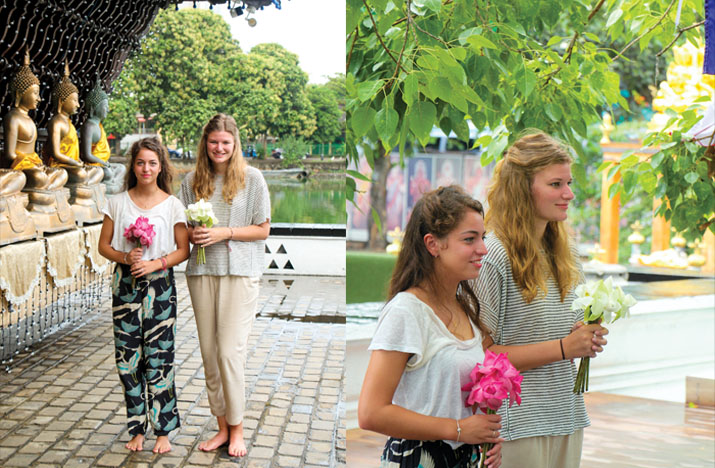
Capital : Sri Jayawardenepura Kotte.
Commercial center : Colombo.
Area : 65,606 sq kms (25,322 sq miles).
Dialing code : +94.
President : Excellency Mr. Gotabaya Rajapaksa.
Prime minister : Excellency Mr. Mahinda Rajapaksa.
Official languages : Sinhala, Tamil. English is widely used and understood in
tourist areas.
Religion : Buddhism (69%), Hinduism (16%), Islam (8%), Christianity (7%).
Population : 21.4 million.
Time : Sri Lanka is 5.30 hours ahead of Greenwich Time (GMT +05.30).
International Airport : Bandaranaike International Airport,
Katunayake (34km north of Colombo).
Currency : Sri Lankan Rupee (one Rupee = 100 Cents).
Exchange Rate : Approx. Sri Lanka Rs. 160 = $1 USD.
Highest Water Fall : Bambarakanda – 241 meters.
Highest Peak : Pidurutalagala – 2524 meters.
Longer River : Mahaweli – 335 Km.


Climate
The Climate in Sri Lanka is tropical and consists of very distinctive dry and wet seasons. The average temperature of Sri Lanka usually ranges from 28 – 32 degrees Celsius which may differ due to global weather conditions. The temperature can vary from being as low as 16 degrees Celsius in Nuwara Eliya which belongs to the central up country and to as high as 32 degrees in Batticaloa along the Eastern coast of the island. However there are certain areas along the coast that are cooled by the ocean breezes. The coldest months according to the mean monthly temperature are December and January while the warmest months are April and August.Climatically Sri Lanka has no off season.
Culture of Sri Lanka
Sri Lanka is one of the few countries with a vast and rich cultural diversity. Culture itself is very unique and contributes to the identity of Sri Lanka. Sri Lankan culture includes many customs and rituals, dating back more than 2000 years, handed down from generation to generation. The most important feature of Sri Lanka is its colorful festival, which is one of the main tourist attractions. Religion plays an important role in the molding of Sri Lanka’s culture and traditions.
Sri Lankan culture if often reflected by the use of art, architecture, sculptures and even food. Some people would say that Sri Lanka has a more conventional culture, obviously influenced by the important religions that prevail in the country such as Buddhism, Hinduism, Islam and so on. Sri Lanka’s way of life is very simple and full of humility and happiness. it is one of the reasons Sri Lanka has a great sense in appreciating simple things in life like nature.


Accommodation
Hotels in Sri Lanka are rated from 1 to 5 stars. In Sri Lanka you have a wide choice of accommodation that meets your budget, from 5-star international chain hotels to elegant colonial palaces, to Basic Beachside Guesthouses. Along with the rapid development of tourism, a number of hotels and tourist resorts have been established in many cities. Generally Hotels in many cities offer many facilities and hotels in rural and remote parts of the island offer less facilities.
Clothing
Light-weight Cotton Clothing is recommended. It is a good idea to be conservatively dressed on the streets while Shorts &Short Skirts are NOT PERMITTED in Places of Buddhist Temple. Footwear MUST BE REMOVED Before Entering TEMPLES. A Sweater is a Must in the Hill Country.


Photography, Restrictions and Permits
Sri Lanka is a tremendously photogenic island, so it.s hardly surprising that most tourists bring a camera of some kind when they visit the country. The stunning landscapes and fascinating architecture photography proreasures offer infinite photographing opportunities. Just remember that there are some restrictions on photographing when visiting temples or religious sites. Please check with You Guide, Chauffeur or at the Temples .Any photographing behaviors that show disrespect are not allowed, for instance, taking pictures in front or beside any statues and murals, using flashing photography (may cause damage to old murals).
Whenever ENTERING HOLY SITES, SHRINES, or TEMPLES and even DAGOBAS , Modest Dresses with Shoulder and Legs Covered is Required and Taking Off Shoes is a MUST Talking Loudly or Disrespectfully, Eating or Drinking, or Pointing Feet at any Buddha Images Inside TEMPLES are NOT ALLOWED.
Foods
influenced by Indian cuisine, standard foods in Sri Lanka are spicy, pungent and curry-related. Chicken, seafood, rice and curry made of bread, banana flour and aubergines are important items on a Sri Lankan table. Travelers can find Chinese, Continental, Indian and Japanese cuisine served in Colombo and other major cities in hotels and resorts. Sri Lankans are used to eat with hands, but forks and spoons are offered in the Good Restaurants & Hotels.


Best Time to Visit
generally Sri Lanka is a holiday destination throughout the year. Located in the tropical area, this country is somewhat influenced by the monsoon climate. Due to different terrestrial forms, the monsoon hits the southern and western parts of Sri Lanka from May to September and can bring some rains during this period. So the best time to visit Sri Lanka travels to the east is Trincomalee, Pasikudha, Arugambay etc.
For the west and south coast the best time to travel will be from December to early April.
